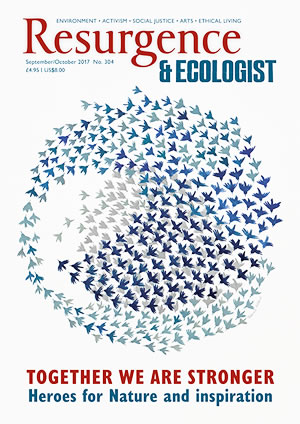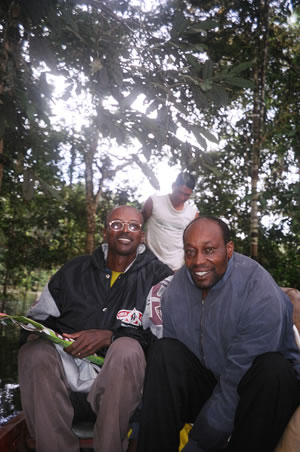Thomas Berry, the American cultural historian, priest, poet and “geologian”, had the capacity to pierce through to the essence of the dynamics of our time with fresh ideas and language – from a radical critique of the petroleum era to a profound mystical perspective – with compassion but detachment. It was while he was writing his last book, The Great Work (published in 1999), that I, together with other colleagues from the Gaia Foundation, had the privilege of participating in many discussions with him about his diagnosis of the need “to transform all modern industrial institutions – economics, education, religion, politics, law and governance – from an anthropocentric preoccupation to an Earth-centred understanding of our role and responsibilities as humans embedded in the larger Earth community”.
Berry, who died in 2009 at the age of 95, emphasised that the most pernicious of these institutions is the modern conception of law, where legislation is used to legitimise destruction. It is for this reason that he promoted the need for a new jurisprudence as a priority, inspired by the Indigenous understanding of law, inherent in the order of life, to be discovered, not made by humans. He insisted that ‘Earth jurisprudence’ was the correct term, as it is the very conception of law that needs to change, and thereby our relationship with Nature. Once we recognise that we are born into a lawful and ordered universe and that our wellbeing is derived from complying with these laws, this understanding should permeate the transformation of all the other modern institutions.
Mama Jacinto, a Kogi Indigenous elder from the Sierra Nevada de Santa Marta in Colombia, reflects a similar understanding: “Since time immemorial, the sacred territory of the Sierra Nevada has been the foundation of our culture. It contains the laws and the symbols that determine our way of thinking and our identity. We should all comply with these norms and laws to safeguard the universe.
“The role of ancestral custodians of the territory is based on knowledge about everything that lives in our territory. In other words, Nature teaches us how to live in harmony. She is an open book where we learn about her stories and about her past. This is what our children and the children of future generations will learn.
“This same knowledge allows us to remember the role of our ancestors, the real meaning of each individual and our mission as humans, responsible for caring for the planet. All life on our planet is threatened when this sense of responsibility is abandoned.”
This thinking resonates with Indigenous shamans from the Colombian Amazon with whom the Gaia Foundation has also been working in recent years. They are deeply concerned that the dominant industrial growth economy consistently breaks the laws that govern life. “The consequences will be severe,” said shaman Rodrigo from Pia Paraná. “Those who believe that humans are superior and can override Nature’s laws are destabilising Mother Earth, and the consequences will affect everyone. It will lead to sickness and chaos for the Earth, and for all who depend on her, including humans. What we do to the Earth, from whom we are born, we do to ourselves. We are part of the web of life. This is the way things are, whether we see it or not.”
We are now living that time. Things are falling apart dramatically and chaos is growing. As the Earth’s systems unwind – from rapid melting of the Arctic, to extreme droughts and floods as climate becomes more unstable, to ocean acidification and ecological tipping points – we see human societies doing the same. In the last throes of monopoly capitalism, the super-rich are rampaging the Earth with shameless brutality to extract what they can, destroying greater numbers of human and ecological communities. Social movements are asking, “What now?” as they develop strategies to converge and reach the growing number of disenfranchised citizens.
It is no longer those at the fringes calling for systemic change. However, the question is, what is at the heart of the paradigm shift required of us?
For Gaia, what is required of us now is the transformation from the dominant anthropocentric obsession that underpins this brutality towards life, to an Earth-centred worldview. As Einstein purportedly said, we cannot solve a problem with the same thinking that created it. Whatever we put in place for human justice will come to nothing if there is no justice for the rest of the community of life, increasingly in tatters, on whom we depend to maintain conditions for life as we know it. As Rodrigo pointed out, this is the way things are, whether we see it or not.
The paradox is that it takes time to decolonise our minds and to experience ourselves as participants with the community of life around us, so that our actions are enhancing to all life. This does not happen through reading the plethora of information out there. It comes through rebuilding our relationship with Nature, so that we experience our reciprocal relationship from within the web of life: the living soils, home to a myriad of creatures that together nurture plant life, so that we mammals can live and the birds and insects can also play their vital roles in weaving the web of life. This requires us to see holistically, to see the dynamic interplay in an interdependent world of relationships.
With the dawn of the new millennium, the Gaia Foundation, inspired particularly by Indigenous people and Thomas Berry, began to develop immersion experiences – such as delving into African Indigenous cosmology and conceptions of law with sangomas (traditional doctors) in Botswana, and setting up learning exchanges to the Colombian Amazon. We took African civil society leaders to experience how Indigenous communities in the Amazon have revived and enhanced their traditional knowledge, practices and governance systems and developed their own endogenous health and education programmes across their territories. Through this work the Indigenous communities have gained legal recognition as the custodians of their ancestral territories, safeguarding 26 million hectares of tropical rainforest.
Motivated, the African leaders returned to their various countries to search for knowledgeable elders as the Amazonians had advised. They initiated community dialogues to recall the memory of their traditions with the elders – the indigenous seeds, medicines, sacred natural sites, the seasonal calendar and rituals and the customary laws that had been in place prior to colonisation. They found, as in the Amazon, that the elders had lost confidence, having been told that they were illiterate and uneducated, that their traditions were backward, and that their recognition of ancestors and sacred sites was devil worship. It took time for the elders and their communities to rebuild their confidence, to revive their memory and to restore their knowledge and practices.
Through this process, a number of African civil society leaders began a journey of learning with their elders about their roots and the holistic worldview of their traditions. They were excited to see that what they had experienced in the Amazon was echoed in Africa. For example, their elders explained that customary laws are derived from the laws of the land and understood to be essential for the human community to govern themselves such that they maintain their harmony with the wider community of life.
There are three interconnected dimensions that are imbued with consciousness, they say: the human world, the world of Nature and the world of spirit and ancestors. The role of sacred natural site custodians is to communicate with Nature and the spiritual world, to guide the human community to sustain the balance between these dimensions.
Since 2012, a number of precedents have been realised through this work with communities in various countries. For example, in Ethiopia sacred natural sites and custodial governance systems have been restored and recognised by local government; in Benin the first national law recognising sacred forests has been established; in South Africa clans have developed their own constitutions and documented the customary laws to assert their practices; and similar work is taking place in Uganda, Kenya, Zimbabwe and Ghana.
As the path of reviving Indigenous knowledge and practices has gained momentum and begun to spread across the African continent, so those working with communities have identified the need for a more in-depth study of Earth jurisprudence and the Amazonian methodology. The Gaia Foundation agreed to pioneer a three-year training course for ‘barefoot’ Earth jurisprudence practitioners, alongside induction trainings for more communities and coalitions to respond to the growing interest.
Berry identified two sources of inspiration for Earth jurisprudence: Nature herself as the primary text, and Indigenous traditions that derive their customary laws and governance systems from observing the laws of Nature.
The training for practitioners involves four interrelated aspects. Personal practice is at the core, developing our relationship with Nature, learning from elders and complying with the laws of Nature in the way we live our lives. Another aspect includes understanding the philosophical underpinnings of Earth jurisprudence, holistic science, Indigenous knowledge systems, the dominant industrial growth economy, the growing alternatives, and how systems change. Thirdly, exploring the guiding principles of the Amazonian methodology for reviving and enhancing Indigenous traditions. And finally, developing participatory learning processes for communities and civil society and associated facilitation skills.
Drawing on the work over the years, the Gaia Foundation, together with our African partners and sacred site custodians, has called on the African Commission on Human and Peoples’ Rights to recognise sacred natural sites and territories and their customary governance systems and assert that these ancestral lands should be safeguarded from any industrial activity. A resolution will be voted on later this year.
Last year, at the world’s largest environmental gathering, the IUCN World Conservation Congress, we presented a similar resolution, which finally received overwhelming support from government and civil society for recognising that all protected areas and Indigenous sacred natural sites and territories should be no-go areas for mining and other destructive industrial activities.
Also in 2016, there was an unprecedented global discussion on Earth jurisprudence, as part of the UN General Assembly’s commitment to promote harmony with Nature. A report on the dialogue emphasises the crucial importance of going beyond anthropocentrism to establish an Earth-centred relationship with our planet. This Earth-centred worldview should underpin the implementation of the UN Sustainable Development Goals, says the report. It recognises the Gaia Foundation’s work to build the alternatives to our current paradigm, including “the training of Earth jurisprudence facilitators … and the growing African Earth jurisprudence network”.
This year the first three-year training in Earth jurisprudence will be completed, with practitioners graduating and the second course beginning. Practitioners have become passionate advocates: one says, “This training awakens a profound sense of belonging to an animate orderly universe. When you see the world in this way, you cannot stop yourself from enthusing others. It becomes a way of life, a calling at this time of chaos and confusion. And more people are ready for this message as things fall apart.”







